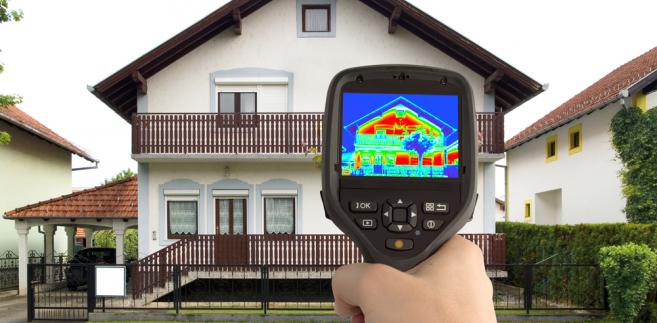 Single-family houses designed today, especially passive houses, they should resemble a thermos flask, both in terms of structure and properties. Means, that they must have a very durable structure, perfect tightness and thermal insulation. Otherwise, all building elements must be designed and constructed in accordance with applicable standards.
Single-family houses designed today, especially passive houses, they should resemble a thermos flask, both in terms of structure and properties. Means, that they must have a very durable structure, perfect tightness and thermal insulation. Otherwise, all building elements must be designed and constructed in accordance with applicable standards.
Comparison of thermal insulation of external partitions in modern single-family houses.
| Type of partition | Max. value of the heat transfer coefficient Uk [W/m²K]* | |
| The house complies with the regulations | passive house | |
| Exterior walls | 0,30 (0,25) | 0,15 (0,10) |
| Windows | 2,90 (1,30) | 1,00 (0,80) |
| Roof or flat roof | 0,|0 (0,20) | 0,15 (0,10) |
| Ceiling above the basement | 0,00 (0,33) | 0,15 |
| * Values considered to be desirable are given in parentheses | ||
In a passive house, meeting the thermal insulation criterion is quite difficult while maintaining a reasonable thickness of the partition. For example, a wall of cellular concrete without insulation, varieties 400 it would have to be at least thick 72 cm and made of solid brick, until 5 m! For this reason, it is more profitable to build partitions taking into account insulation. Then relatively thin, but a load-bearing wall or building board and a suitable thickness will take care of it 40-55 cm, which of course is acceptable.
Calculation of the thermal insulation of the partition, i.e. the heat transfer coefficient U [W/m²K] it's fairly easy. It consists in calculating the thermal resistance R. [m²K/W] separately for each layer. To do this, divide the material thickness d [m], by the corresponding thermal conductivity coefficient X [W / mK] That is:
R = d / λ
The obtained results are added up and the so-called. heat transfer resistance on the inner surface Rsi [m2 K/W] and outer Rse [m2K / W], which depend on the direction of the heat flow:
• up, that is through the ceiling or roof Rsi + Rse = 0,10+0,04 = 0,14,
• horizontally, that is through the outer walls Rsi + Rse = 0,13+0,04 = 0,17,
• Down, that is, through the floor or ceiling above the basement Rsi + Rse = 0,17+0,04 = 0,21
In this way, the total thermal resistance of the partition Rt is obtained [m2K / W], That is:
Rt= Rsi+R,+R2 +…+Rn+Rse
The reciprocal of the total thermal resistance is the U0 heat transfer coefficient of the partition which is just calculated [W/m²K], ie U0 = l / Rt. Obviously, the obtained result does not take into account possible thermal bridges. Their calculation is quite complicated, and the use of permitted simplifications with regard to the Passive House does not make sense, because it would increase the results by 30 – 150%. It should therefore be adopted, that the result is correct for the full partition part.
However, you must know, that the investor does not have to count anything. It is the designer's task. However, to check the correctness of the results or just find out the required thickness of the thermal insulation, it is enough to use the table .
Other layers were not taken into account when calculating the thickness of the thermal insulation (load-bearing, shields, finishing), which usually have a small effect on the improvement of the thermal properties of the partition.
Comparison of selected thermal insulation materials
| Material | Density[kg/m3] | Thermal conductivity X [W / mK]* | Thickness for U = 0.15 W / mzK [cm] | Thickness for U = 0.10W / m l< [cm] |
| Straw | 300 | 0,08 | 52 | 79 |
| Cane | 2R250KSS | 0,07 | 45 | 69 |
| Glassware | 180 | 0,07 | 45 | 69 |
| Tile | 150 | 0,045 | 2944 | |
| Insulating | 300 | 0,06 | 39 | 59 |
| Foam | 30-50 | 0,035 | 23 | 34 |
| polyurethane | 50-150 | 0,045 | 29 | 44 |
| Fibers of cellulose | 30-65 | 0,042 | 27 | 41 |
| Styrofoam | 10 | 0,045 | 29 | 44 |
| 12 | 0,043 | 28 | 42 | |
| 15-40 | 0,040 | 26 | 39 | |
| Wool | 40-80 | 0,045 | 29 | 44 |
| mineral | 100-160 | 0,040 | 27 | 41 |
| Vataszklana | 60-100 | 0,045 | 29 | 44 |
| Wood chips | 150 | 0,07 | 45 | 69 |
| * The table shows the values of the thermal conductivity coefficient in accordance with the PN standard | ||||
For example, a two-layer wall made of sand-lime blocks thick 18 cm, insulated with mineral wool thick 27 cm is characterized by the heat transfer coefficient Uο = 0.146 W /(m2 K). The use of lower values of the coefficients in the calculations (declared by some material producers) can reduce the thickness of the insulation to approx 20 cm. However, in a Passive House, even then, it is worth designing thickness insulation 25 – 35 cm, to achieve the best possible insulation of the partition.